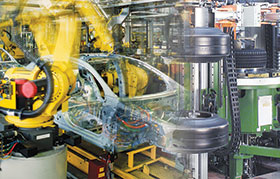

Rockwell Automation’s Gauteng-based systems and solutions (SSB) team has executed two separate projects at a tyre processing plant in Port Elizabeth. The back-to-back projects will assist the manufacturer to maintain continuous and safe production.
The first project (the rubber mill feed project) included the design and implementation of a Rockwell Allen Bradley PowerFlex AC variable speed drive (VSD) solution, forming part of the manufacturer’s in-house optimisation project. It involved the addition of a two-roll rubber feed mill to aid in meeting the critical demand of downstream processes.
The second project (the Banbury mixer project) involved replacing obsolete drives for one of the plant’s Banbury mixers. Allen Bradley PowerFlex modular DC drives were implemented with a Rockwell Connected Enterprise approach.
Rubber mill feed project
This project entailed the expansion of the rubber feeding process by the addition of a standalone two roll feed mill. The rationale was to have redundancy in the event of a drive or mechanical failure. The new mill furthermore allows for variable speed operation, optimally feeding the calendaring process.
The scope of work included the design, construction and commissioning of a VSD panel for the 150 kW, 400 V AC feed mill motor. A PowerFlex 755 was chosen for this application. This allowed expansion by installing multiple digital I/O, feedback and safety option cards, with the additional benefit of on-board programmable logic.
Rockwell Automation implemented the control philosophy provided by the machine-motor integrator for the project. This included programming software functionality in the VSD using the on-board DeviceLogix and integrating speed control encoders with an Allen Bradley safety relay.
Banbury mixer project
The Banbury mixer project involved replacing four obsolete third-party drives and their panels used for one of the manufacturer’s Banbury mixers. The mixers are used to mix the raw materials that form the rubber compound.
The Rockwell Integrated Architecture-based solution, which allows for Ethernet enablement, replaced the older hard-wired technology. The migration of the safety and control of the mixer drives on to the newly installed GuardLogix safety PLC provides the ideal platform for future complete mixer control upgrades.
Two 0,75 MW total motors drive the mixer through a common gearbox. Essentially, four DC drives were replaced with a two-drive modular system using locally sourced Semikron SCR power modules interfacing to an Allen Bradley standalone DC Drive Regulator (SAR) module. This removes the requirement of having two drive interfaces per one motor, at the same time reducing system complexity, and minimised failure potential due to physical segregation and electrical isolation of power and control devices.
Each 0,75 MW DC motor is fed from a 30 degree phase shifted, 550 V AC dual supply, which makes up a 12-pulse drive. The PowerFlex DC SAR module is scalable up to four parallel power units, either regenerative or non-regenerative. A major safety net is provided with a PowerFlex SAR -based 12-pulse arrangement in that cross conduction (plus to minus) cannot take place between two regenerative SCR bridges. The scaling of voltage and current feedback to the SAR is fully programmable. It is thus also ideal for retrofitting applications where existing SCR stacks are re-used.
In the case of the Banbury mixer, any of the two identical SAR interfaces can be configured to be the master drive for the system. This prevents the dependency on one specific drive to always be available. One motor can be shut down and the machine operated at reduced capacity. There are no direct power connections between the two new drive panels, which are separate.
Interfacing with the third-party PLC was done through an Allen Bradley networked Point IO, communicating to the safety PLC and drives via a Stratix 5700 managed switch. This permitted sufficient network integrity to handle critical communications like safety I/O and load sharing between motors. Controlling all the electrical safety devices directly in the new drive panels resulted in an 80% field wiring reduction and also enabled pin-point fault-finding.
One of the challenges overcome was the tight time frame right through from order acceptance to project completion. Another was to remove the old and install and commission the new panels, working in a confined and raised electrical room together with the Rockwell Automation appointed installation company.
For more information contact Devo Pillay, Rockwell Automation, +27 11 998 1058, [email protected], www.rockwellautomation.co.za
| Tel: | +27 11 654 9700 |
| Fax: | +27 11 654 9702 |
| Email: | [email protected] |
| www: | www.rockwellautomation.com |
| Articles: | More information and articles about Rockwell Automation |

© Technews Publishing (Pty) Ltd | All Rights Reserved